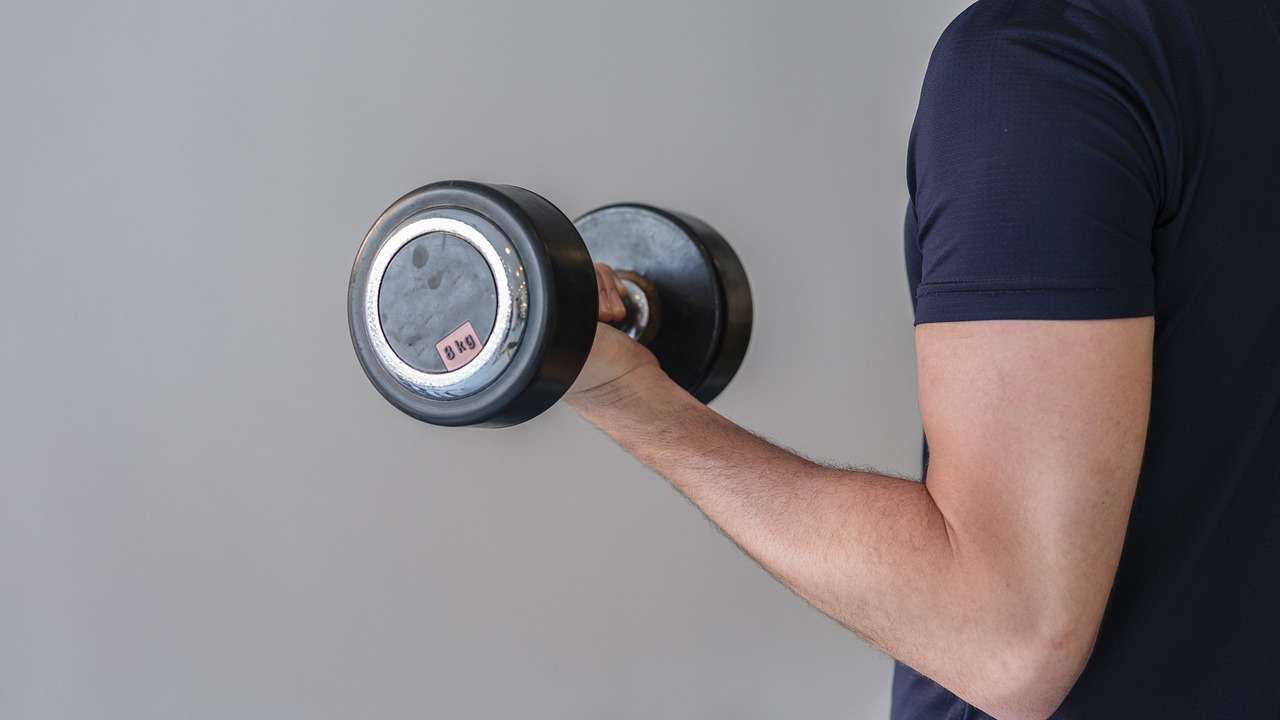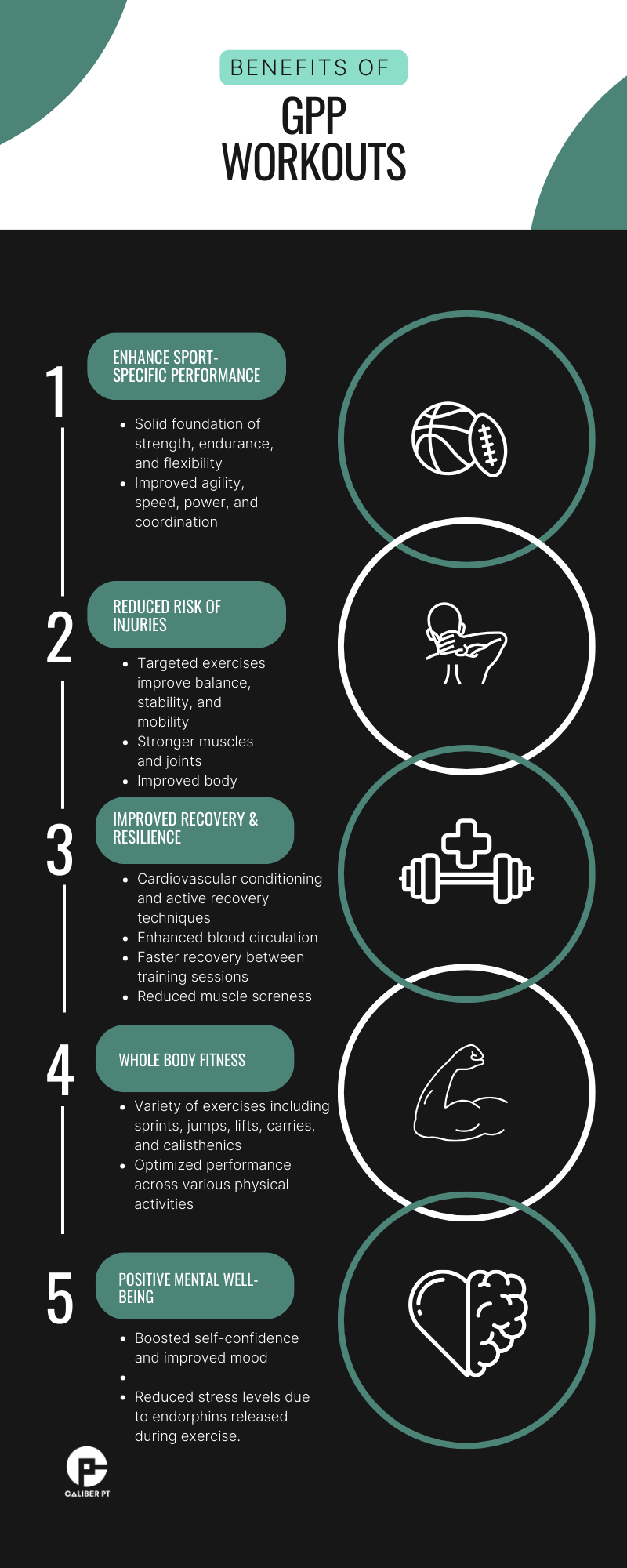© Copyright 2023 Caliber PT PLLC - All Rights Reserved

First, What is GPP?
GPP, or General Physical Preparedness, refers to a type of workout that focuses on developing overall athleticism and physical fitness. Unlike specific training programs that target specific muscle groups or skills, GPP workouts aim to improve general physical abilities that are essential for athletic performance. These workouts involve a wide range of exercises that challenge different aspects of fitness, including strength, endurance, flexibility, and coordination.
The goal is to develop a well-rounded foundation of physical abilities that can be applied to any sport or activity.
The primary focus of GPP workouts is to enhance overall physical preparedness rather than specializing in one specific area. This means that athletes engage in exercises that target multiple muscle groups simultaneously and emphasize functional movements.
Benefits of GPP Workouts in Athletic Performance
GPP plays a vital role in enhancing athletic performance by addressing the fundamental components required for success in any sport. It serves as the building block upon which specialized skills and techniques can be developed. Here are some key ways in which GPP workouts contribute to improved athletic performance:
Enhancement of basic physical qualities: GPP workouts aim to improve an athlete’s strength, speed, endurance, flexibility, and coordination. These qualities form the foundation for any sports-specific skill.
Development of work capacity: By gradually increasing the intensity and volume of training, GPP programs can help an athlete increase their ability to sustain high levels of work for longer periods. This is crucial for both training and competition.
Injury prevention: Regular GPP workouts can help to strengthen the body’s structural integrity and balance muscular development, which can significantly reduce the risk of injury.
Recovery improvement: Incorporating GPP exercises into a training regime can also aid in recovery from intense specialized training or competition. This is because GPP exercises can promote blood circulation to various parts of the body, helping to speed up the healing process.
By integrating GPP workouts into their training routine, athletes can enjoy a range of benefits that can help them perform at their best. Remember, every athlete is unique and it’s important to tailor any workout program to meet individual needs and goals.
Incorporating GPP into Your Routine
By including GPP workouts in your training regimen, you can enhance your overall athleticism and boost your performance in specific sports or activities.
Start your GPP routine with a dynamic warm-up and end with a cool-down. This prepares your body for the workout, prevents injuries, raises body temperature, and improves joint mobility. A cool-down lowers the heart rate and reduces muscle soreness.
Balance your GPP with sport-specific drills. For instance, a soccer player should still practice dribbling, passing, and shooting. This balance optimizes your performance in your chosen sport.
Adjust the frequency of GPP workouts based on your fitness level and goals. Incorporate GPP into your routine 2-3 times per week for best results. Sessions can last from 30 minutes to an hour, but avoid overdoing it to prevent overtraining and injuries.
GPP exercises are a crucial component of any well-rounded training program, as they target different muscle groups and improve overall athleticism. Let's dive into some effective GPP exercises for different muscle groups that can help you enhance your athletic performance.
Upper Body GPP Exercises
Push-ups: This classic exercise engages multiple upper body muscles, including the chest, shoulders, and triceps. It also activates the core for stability.
Pull-ups: By targeting the back, shoulders, and arms, pull-ups build strength and improve grip. They are an excellent exercise for developing upper body power.
Medicine ball throws: Incorporating medicine ball throws into your routine helps develop explosive power in the upper body. Exercises like overhead throws or chest passes engage the chest, shoulders, and arms.
Battle ropes: This dynamic exercise engages the muscles in your arms, shoulders, and back while also challenging your cardiovascular system. Battle ropes are great for improving endurance and building upper body strength.
Lower Body GPP Exercises
Squats: Squats are a fundamental lower body exercise that targets the quadriceps, hamstrings, glutes, and calves. They improve lower body strength and stability.
Lunges: Lunges work multiple muscles in the legs, including the quadriceps, hamstrings, glutes, and calves. They also engage the core for balance and stability.
Box jumps: Box jumps are an explosive lower body exercise that targets the quads, glutes, and calves while also improving power and coordination.
Sled pushes/pulls: These exercises involve pushing or pulling a weighted sled to activate muscles throughout the lower body. They build strength and endurance while mimicking real-life movements.
Core and Abdominal GPP Exercises
Planks: Planks engage multiple muscles in the core, including the rectus abdominis (six-pack muscles), obliques, and lower back. They improve core strength and stability.
Russian twists: This exercise targets the obliques and helps improve rotational power. Sit on the floor with your knees bent, lean back slightly, and twist your torso from side to side while holding a weight or medicine ball.
Hanging leg raises: By hanging from a bar and lifting your legs, you engage the lower abs, hip flexors, and obliques. This exercise improves core strength and stability.
Bicycle crunches: Bicycle crunches target the rectus abdominis, obliques, and hip flexors. Lie on your back with your hands behind your head, bring one knee towards your chest while simultaneously twisting your torso to touch the opposite elbow.
Incorporating these GPP exercises into your training routine will help you develop overall athleticism by targeting different muscle groups. Remember to start with proper form and gradually increase intensity as you progress. Regularly including GPP workouts in your training regimen can significantly enhance your athletic performance and take you to new fitness heights.
What You Need to Know
When it comes to incorporating GPP workouts into your routine, there are a few key things that you need to keep in mind. First and foremost, it's always a good idea to consult with a fitness professional before starting any new exercise program. They can help assess your current fitness level and provide guidance on how to safely and effectively incorporate GPP workouts into your routine.
Another important aspect of GPP training is gradual progression. It's essential to start at a level that is appropriate for your current fitness level and gradually increase the intensity and volume of your workouts over time. This will not only help prevent injury but also ensure that you continue to make progress and improve your athletic performance.
Proper form and technique are also crucial when it comes to GPP workouts. It's important to learn the correct form for each exercise and focus on maintaining proper alignment throughout the movement. This will not only maximize the effectiveness of the exercise but also reduce the risk of injury.
GPP workouts play a vital role in enhancing athletic performance by improving overall athleticism, strength, endurance, flexibility, and coordination. By incorporating GPP exercises into your routine and following the principles outlined above – consulting with a fitness professional, gradually progressing in intensity, focusing on proper form and technique – you can unlock your full potential as an athlete or fitness enthusiast. So why wait? Start incorporating GPP workouts into your routine today and experience the benefits firsthand! Remember, with Caliber PT by your side, you have access to expert guidance every step of the way. Let us help you achieve your fitness goals and elevate your performance to new heights.
Caliber PT: Your Path to Peak Performance
Unlock Your Athletic Potential with Personalized Physical Therapy Programs


